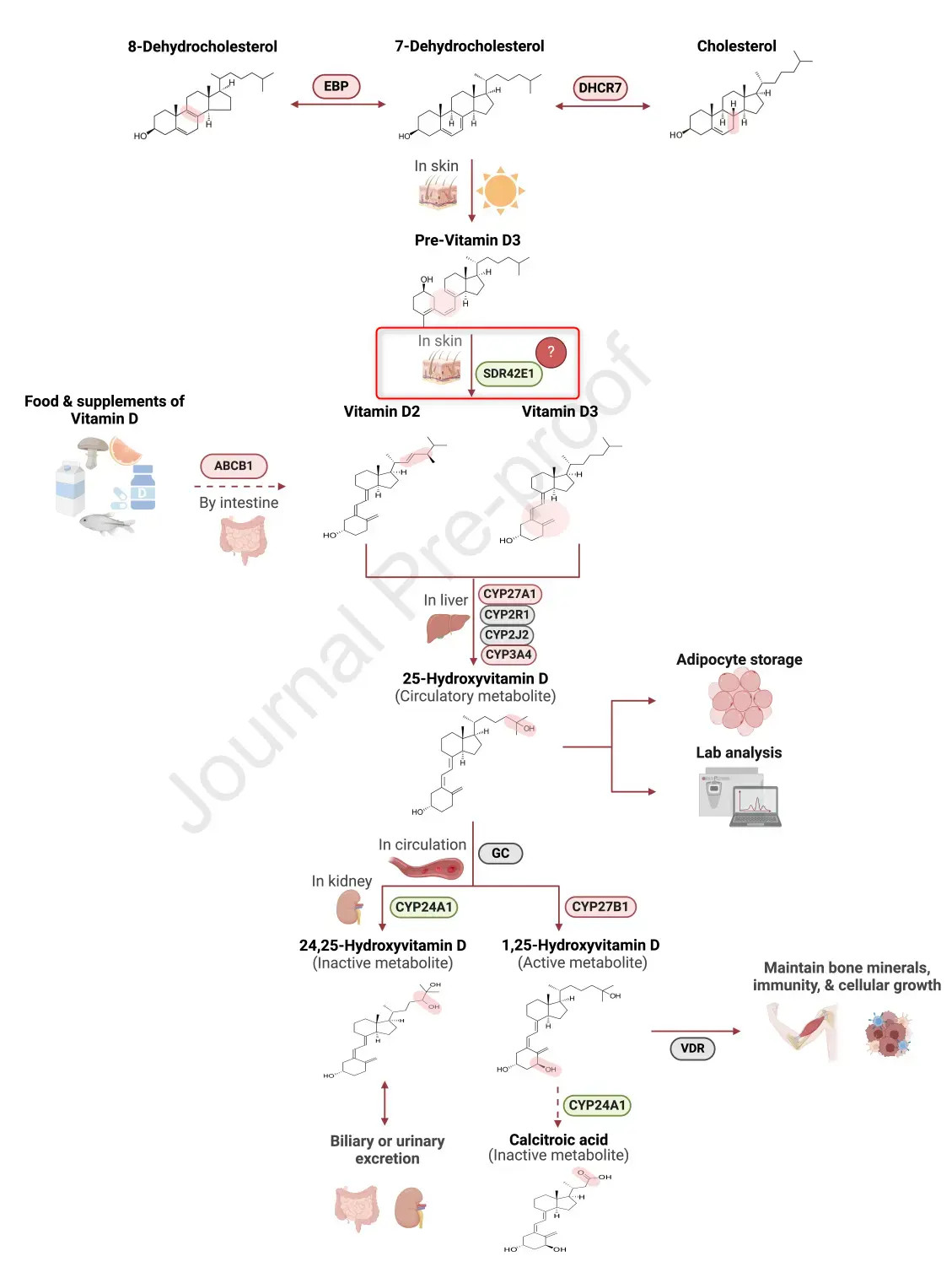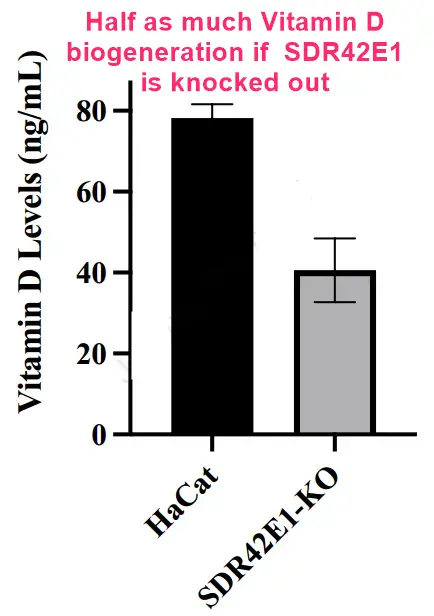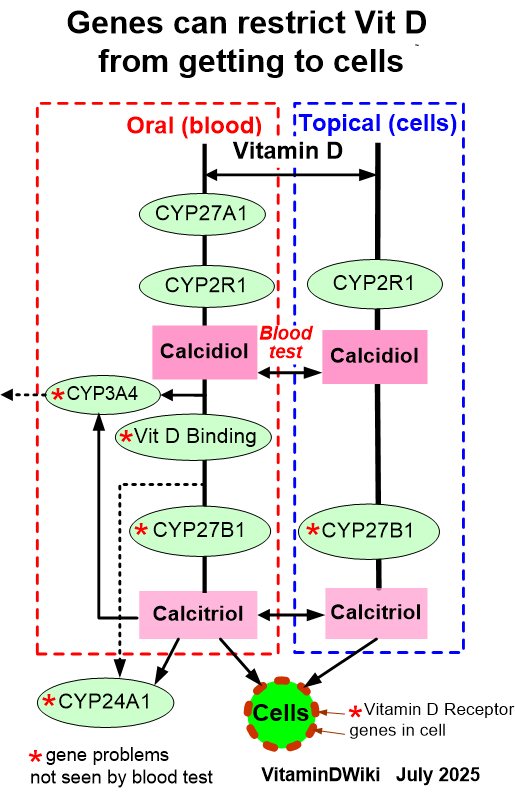SDR42E1 (Vitamin D gene) can greatly reduce Vitamin D from the sun and gut
4 of the items are by the same Jordan author
Functional characterization of the SDR42E1 reveals its role in vitamin D biosynthesis – Aug 2024
Heliyon (Cell Press) https://doi.org/10.1016/j.heliyon.2024.e36466
Nagham Nafiz Hendi , Maria Teresa Bengoechea-Alonso, Johan Ericsson, Georges Nemer


Highlights
SDR42E1 knockout alters key vitamin D synthesis regulators: EBP, DHCR7, ALPP, and CYP26A1.
Multi-omics reveal SDR42E1’s broad role in steroid synthesis and lipid metabolism.
SDR42E1 knockout accumulates 7-dehydrocholesterol, hindering vitamin D production.
SDR42E1 variant presents a promising target for addressing vitamin D deficiency.
Vitamin D deficiency poses a widespread health challenge, shaped by environmental and genetic determinants. A recent discovery identified a genetic regulator, rs11542462, in the SDR42E1 gene, though its biological implications remain largely unexplored. Our bioinformatic assessments revealed pronounced SDR42E1 expression in skin keratinocytes and the analogous HaCat human keratinocyte cell lines, prompting us to select the latter as an experimental model. Employing CRISPR/Cas9 gene-editing technology and multi-omics approach, we discovered that depleting SDR42E1 showed a 1.6-fold disruption in steroid biosynthesis pathway (P-value = 0.03), considerably affecting crucial vitamin D biosynthesis regulators. Notably, SERPINB2 (P-value = 2.17 x 10−103), EBP (P-value = 2.46 x 10−13), and DHCR7 (P-value = 8.03 x 10−09) elevated by ∼2-3 fold, while ALPP (P-value < 2.2 x 10−308), SLC7A5 (P-value = 1.96 x 10−215), and CYP26A1 (P-value = 1.06 x 10−08) downregulated by ∼1.5-3 fold. These alterations resulted in accumulation of 7-dehydrocholesterol and reduction of vitamin D production, as evidenced by the drug enrichment (P-value = 4.39 x 10−06) and vitamin D quantification (R2 = 0.935, P-value = 0.0016) analyses. Our investigation unveils SDR42E1's significance in vitamin D homeostasis, emphasizing the potential of precision medicine in addressing vitamin D deficiency through understanding its genetic basis.
📄 Download the PDF from VitaminDWiki
In silico characterization of the novel SDR42E1 as a potential vitamin D modulator – April 2024
J of Steroid Biochemistry and Molecular Biology Vol 238, April 2024, https://doi.org/10.1016/j.jsbmb.2023.106447 PDF is behind a paywall
Nagham Nafiz Hendi a, Georges Nemer a b
Highlights
SDR42E1 protein demonstrates a strong affinity for key vitamin D intermediates, notably 8-dehydrocholesterol.
The evolutionary conservation of hydrophobic interactions between vitamin D and SDR42E1 emphasizes its crucial role in regulating vitamin D skin synthesis.
The short-chain dehydrogenase/reductase (SDR) superfamily encompasses enzymes that play essential roles in the metabolism of steroid hormones and lipids. Despite an enigmatic function, recent genetic studies have linked the novel SDR 42 extended-1 (SDR42E1) gene to 25-hydroxyvitamin D levels. This study investigated the potential SDR42E1 functions and interactions with vitamin D using bioinformatics and molecular docking studies. Phylogenetic analysis unveiled that the nucleotide sequences of human SDR42E1 exhibit high evolutionary conservation across nematodes and fruit flies. Molecular docking analysis identified strong binding affinities between SDR42E1 and its orthologs with vitamin D3 and essential precursors, 8-dehydrocholesterol, followed by 7-dehydrocholesterol and 25-hydroxyvitamin D. The hydrophobic interactions observed between the protein residues and vitamin D compounds supported the predicted transmembrane localization of SDR42E1. Our investigation provides valuable insights into the potential role of SDR42E1 in skin vitamin D biosynthesis throughout species. This provides the foundation for future research and development of targeted therapies for vitamin D deficiency and related health conditions.
Genome-Wide Association Study of Vitamin D Deficiency in the Middle East With a Relevant Characterization of the Novel SDR42E1 Gene – April 2023
ProQuest Dissertations & Theses, 2023. 30420472.
Hendi, Nagham Nafiz Ahmad . Hamad Bin Khalifa University (Qatar)
📄 Download the preview PDF from VitaminDWiki
210 page PDF is too large for VitaminDWiki
SDR42E1 modulates vitamin D absorption and cancer pathogenesis: insights from an in vitro model - July 2025
Front. Endocrinol., 17 July 2025, Sec. Molecular and Structural Endocrinology .Volume 16 - 2025 | https://doi.org/10.3389/fendo.2025.1585859
Nagham Nafiz Hendi ,&#x;Nagham Nafiz Hendi1,2†Georges Nemer,&#x;Georges Nemer2,3†
1Faculty of Pharmacy, Middle East University, Amman, Jordan
2Division of Genomics and Translational Biomedicine, College of Health and Life Sciences, Hamad Bin Khalifa University, Doha, Qatar
3Department of Biochemistry and Molecular Genetics, American University of Beirut, Beirut, Lebanon
Introduction: Vitamin D is a pleiotropic hormone essential for bone health and overall physiological function. Despite its significance, vitamin D deficiency remains widespread and is often influenced by genetic factors.
Methods: This study investigates the role of SDR42E1, a gene encoding a short-chain dehydrogenase/reductase enzyme, in vitamin D regulation and sterol metabolism. Using CRISPR/Cas9 gene-editing, we generated an SDR42E1 knock-in model in HCT116 colorectal cells, which exhibit high endogenous SDR42E1 expression, harboring a nonsense variant associated with vitamin D deficiency.
Results: Integrated transcriptomic and proteomic analyses revealed significant dysregulation of sterol absorption and metabolism (fold change (FC) = 1.8, P = 0.007) and cancer-related signaling pathways (FC = −1.7, P = 0.02). Notably, key differentially expressed genes included upregulated LRP1B and ABCC2, alongside downregulated WNT16 and SLC7A5. Proteomic profiling confirmed alterations in cell proliferation-related proteins, including reduced ALDOA expression (FC = −0.37, P = 0.0005). Functionally, SDR42E1 deficiency reduced cell viability by 53% (P = 0.0001), an effect reversed by transient SDR42E1 overexpression with restoring ABCC2 expression.
Conclusion: These findings establish SDR42E1 as a key modulator of vitamin D-related pathways and highlight its potential as a therapeutic target for addressing vitamin D deficiency and associated pathologies, including cancer.
📄 Download the PDF from VitaminDWiki
Association Between SDR42E1 Gene and Vitamin D – Perplexity AI report July 2025
Overview of the Association
Yes, there is a significant association between the SDR42E1 gene and vitamin D metabolism.
The SDR42E1 (Short Chain Dehydrogenase/Reductase Family 42E, Member 1) gene encodes a short-chain dehydrogenase/reductase enzyme that has been identified as a key regulator of vitamin D homeostasis and sterol metabolism 1 2 3.
Genetic Association with 25-Hydroxyvitamin D Levels
Large-scale genome-wide association studies (GWAS) have identified 143 independent loci associated with 25-hydroxyvitamin D (25OHD) concentrations, with SDR42E1 being among the genes implicated in vitamin D regulation 4. Specifically, genetic variants in SDR42E1 have been linked to 25-hydroxyvitamin D levels, though the precise function of this novel gene remained elusive until recent studies 2 3.
Vitamin D Biosynthesis Regulation
Research using CRISPR/Cas9 gene-editing technology has revealed that SDR42E1 depletion significantly disrupts steroid biosynthesis pathways , with a 1.6-fold disruption (P-value = 0.03) that considerably affects crucial vitamin D biosynthesis regulators 5 6. Key findings include:
SERPINB2 elevated by ~2-3 fold (P-value = 2.17 × 10⁻¹⁰³)
EBP (emopamil-binding protein) elevated by ~2-3 fold (P-value = 2.46 × 10⁻¹³)
DHCR7 (7-dehydrocholesterol reductase) elevated by ~2-3 fold (P-value = 8.03 × 10⁻⁹)
ALPP (alkaline phosphatase) downregulated by ~1.5-3 fold (P-value < 2.2 × 10⁻³⁰⁸)
CYP26A1 downregulated by ~1.5-3 fold (P-value = 1.06 × 10⁻⁸) 5
Impact on Vitamin D Precursors
The disruption of SDR42E1 function results in the accumulation of 7-dehydrocholesterol and reduction of vitamin D₃ production , as evidenced by drug enrichment analysis (P-value = 4.39 × 10⁻⁶) and total vitamin D quantification (R² = 0.935, P-value = 0.0016) 5 6.
Molecular Docking and Binding Affinity
Molecular docking studies have revealed that SDR42E1 demonstrates strong binding affinities with vitamin D compounds and their precursors 2 3:
Vitamin D₃ (cholecalciferol)
8-dehydrocholesterol (highest affinity)
7-dehydrocholesterol
25-hydroxyvitamin D
The hydrophobic interactions between protein residues and vitamin D compounds support the predicted transmembrane localization of SDR42E1, with critical residues like tyrosine 142 and glutamine 131 facilitating these binding affinities 2 3.
Disease Associations
Research has identified pathogenic mutations in SDR42E1 associated with a novel syndrome termed "oculocutaneous genital syndrome" 7. This syndrome includes:
Brittle cornea and keratoconus
Hyperelastic skin and joint hypermobility
Sexual developmental abnormalities (micropenis, hypospadias, cryptorchidism)
Low cholesterol levels
Hearing loss and dental abnormalities 7
Cancer Implications
Recent studies have demonstrated that SDR42E1 deficiency reduces cell viability by 53% (P = 0.0001) in colorectal cancer cells, suggesting its potential role in cancer pathogenesis and as a therapeutic target 1 8. The gene modulates sterol absorption and metabolism pathways that are dysregulated in cancer 1.
Expression Patterns and Localization
SDR42E1 shows pronounced expression in skin keratinocytes and intestinal epithelial cells, which aligns with its role in vitamin D biosynthesis since the skin is the primary site of vitamin D₃ synthesis from 7-dehydrocholesterol under UVB radiation 5 6 9. The protein has been localized to the cytoplasm and endoplasmic reticulum membrane 10 11.
Therapeutic Implications
The comprehensive understanding of SDR42E1's role in vitamin D metabolism has significant implications for precision medicine approaches to addressing vitamin D deficiency 1 5. The gene's function in modulating vitamin D-related pathways makes it a potential therapeutic target for:
Addressing vitamin D deficiency
Managing associated pathologies including cancer
Developing targeted therapies for vitamin D-related conditions 1 2
Evolutionary Conservation
Phylogenetic analysis reveals that SDR42E1 exhibits high evolutionary conservation across species, from nematodes to fruit flies to humans, suggesting its fundamental importance in sterol and vitamin D metabolism throughout evolution 2 3. This conservation emphasizes the critical role of this enzyme family in maintaining vitamin D homeostasis across diverse species.
The association between SDR42E1 and vitamin D represents a significant advancement in understanding the genetic basis of vitamin D deficiency and opens new avenues for precision medicine approaches to this globally prevalent nutritional deficiency.
References
https://www.frontiersin.org/journals/endocrinology/articles/10.3389/fendo.2025.1585859/full
https://www.frontiersin.org/journals/endocrinology/articles/10.3389/fendo.2025.1585859/pdf
https://www.sciencedirect.com/science/article/abs/pii/S0014483521002372
https://www.sciencedirect.com/science/article/abs/pii/S0960076023002030
https://www.sciencedaily.com/releases/2025/07/250718031208.htm
https://www.news-medical.net/news/20250718/Study-identifies-SDR42E1s-role-in-vitamin-D-pathway.aspx
https://journals.plos.org/plosgenetics/article?id=10.1371%2Fjournal.pgen.1011033
https://www.sciencedirect.com/science/article/pii/S2405844024124978
https://jamanetwork.com/journals/jamadermatology/fullarticle/548901
https://courses.lumenlearning.com/wm-biology2/chapter/vitamin-d-synthesis/
https://lpi.oregonstate.edu/mic/health-disease/skin-health/vitamin-D
https://www.sciencedirect.com/science/article/pii/S209012321400023X
SDR42E1 reduces Vitamin D from sun/uv AND from intestine - Perplexity AI July 2025
VitaminDWiki - Genetics chart shows the vitamin D genes

VitaminDWiki - Middle East and Vitamin D contains
{include}
See related in VitaminDWiki
Vitamin D genes vary with UVB in Europe, Africa, Asia – March 2020
Vitamin D levels from lowest to highest: Middle East, China. India, S EU. N EU – Dec 2019
Top 5 health concerns of women in UAE (all have been treated by Vitamin D) – April 2018
12 Vitamin D genes (Most are not noticed by blood test) – Sept 2021
GC, CYP2R1, VDR, CYP24A1, DHCR7, CYP27B1, CYP27A1, CASR, PTH, CYP3A4, RXRA, CUBN
